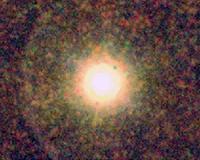 |
Washington DC (SPX) Sep 02, 2010 With a brilliant, finely tuned spark of ultraviolet (UV) light, a physicist at the National Institute of Standards and Technology (NIST) helped NASA scientists successfully position a crucial UV sensor inside a space-borne instrument to observe a "hidden" layer of the Sun where violent space weather can originate. Dark spots on the Sun release particles and electromagnetic fields into space. As these particles and fields pass through the Sun's "transition region," 5,000 kilometers above the surface, they can gather considerable steam, resulting in violent episodes of "space weather" that can damage Earth-orbiting satellites and disrupt electronic communications. The powerful magnetic fields in the transition region can be studied indirectly, by observing the UV light emanating from that region. The fields slightly shift the colors (wavelengths) of UV light released by charged atoms (ions) in their vicinity. Measuring how much these wavelengths shift can yield information on the magnetic field's strength. The catch is you can't do it from Earth, where the atmosphere absorbs the UV light, so a team at NASA Marshall Space Flight Center in Huntsville, Ala., constructed a rocket-borne instrument, known as the Solar Ultraviolet Magnetograph Investigation (SUMI), designed to take pictures of these magnetic fields from space. SUMI observes shifts in the well-known wavelengths of UV light emitted by magnesium and carbon ions caught in the magnetic fields of the transition region. The instrument's optics break down the incoming UV light into a spectrum of individual wavelengths and fans them out, much as a prism fans out white light into a rainbow. The trick is in knowing precisely which wavelength falls where in the instrument and adjusting it so that the desired wavelengths land on the instrument's detectors. "The problem is that SUMI's detectors are small, so they don't capture a wide range of wavelengths," says NIST physicist Joseph Reader. "The issue becomes how to align the complicated optics in the instrument so that the magnesium and carbon lines are recorded on its detectors. The solution is to get a light source that can produce these same lines in the laboratory," he says, and use them to properly adjust the instrument's sensors. Readily available lamps can simulate the UV light from the singly ionized magnesium, but generating the UV light from triply ionized carbon (carbon with three electrons removed) is difficult. Enter NIST's unique "sliding spark source." It consists of a pair of graphite electrodes with a quartz surface in between. A spark from these electrodes glides along the quartz surface, controllably producing the desired wavelengths of UV light from ionized carbon. Inside a clean room in Huntsville, UV radiation from the spark source entered SUMI, enabling its sensors to be accurately positioned before deployment. On July 30, 2010, SUMI was successfully launched from White Sands, N.M. It rocketed 320 km in space and observed sunspot 11092 for about 6 minutes before parachuting back to earth. The Huntsville team is analyzing the data it obtained.
Share This Article With Planet Earth
Related Links National Institute of Standards and Technology (NIST) Stellar Chemistry, The Universe And All Within It
 Herschel Finds Water In Cosmic Desert
Herschel Finds Water In Cosmic DesertPasadena CA (JPL) Sep 02, 2010 The Herschel infrared space observatory has discovered that ultraviolet starlight is the key ingredient for making water in space. It is the only explanation for why a dying star is surrounded by a gigantic cloud of hot water vapor. Herschel is a European Space Agency mission with important participation from NASA. Every recipe needs a secret ingredient. When astronomers discovered an unex ... read more |
|
| The content herein, unless otherwise known to be public domain, are Copyright 1995-2010 - SpaceDaily. AFP and UPI Wire Stories are copyright Agence France-Presse and United Press International. ESA Portal Reports are copyright European Space Agency. All NASA sourced material is public domain. Additional copyrights may apply in whole or part to other bona fide parties. Advertising does not imply endorsement,agreement or approval of any opinions, statements or information provided by SpaceDaily on any Web page published or hosted by SpaceDaily. Privacy Statement |